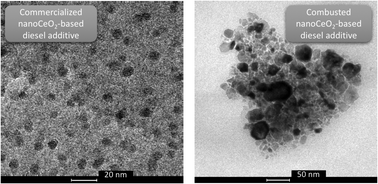Structural and physical–chemical behavior of a CeO2 nanoparticle based diesel additive during combustion and environmental release†
Abstract
The colloidal and chemical stability of CeO2 nanoparticles used in a diesel additive (viz. Envirox™) was studied at different stages of their lifecycle (formulation, use, end of life). After combustion at a temperature close to that of diesel engines, the size of the CeO2 crystallites increased significantly without detectable Ce(III) in the structure and remaining organic compounds at the surface. Regardless of the aging conditions (salinity, light, pH), the dissolution kinetics of the combusted particles were slowed down compared to that of the initial CeO2 nanoparticles. After 2 days at 0.1 g L−1 of salts, no more than 0.01% of the total Ce was released from the 850 °C-combusted Envirox™ versus 1.5% for the uncombusted Envirox™. Both the crystal growth during combustion and the degradation of the organic matrix will govern the aggregation and dissolution kinetics/mechanisms once the CeO2 particles are released into the environment at different stages of their lifecycle. Such a study is a prerequisite needed before any assessment of the environmental risks of CeO2 nanoparticle-based diesel additives is performed.



 Please wait while we load your content...
Please wait while we load your content...